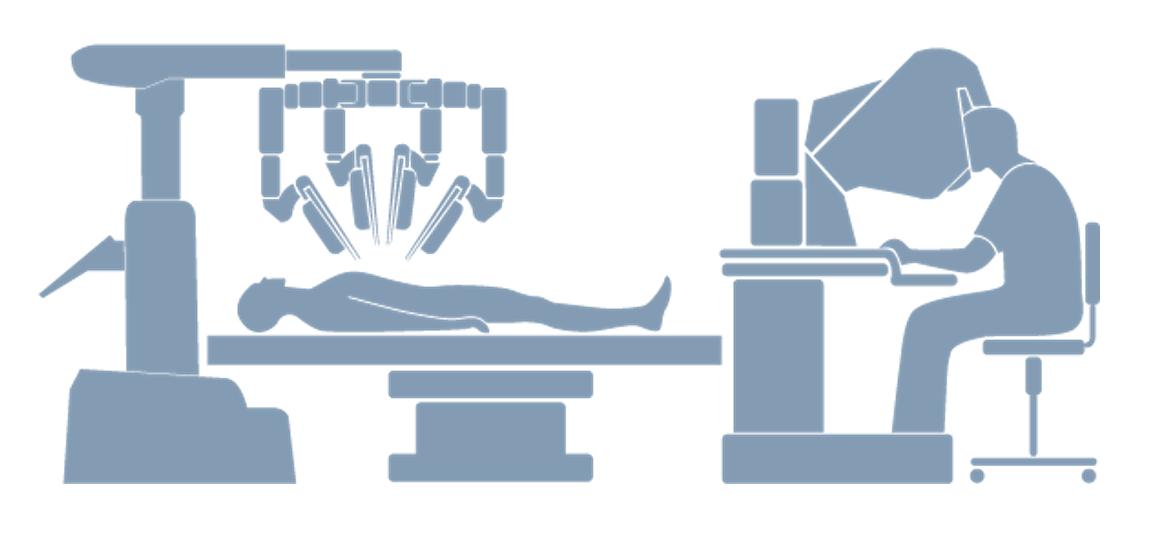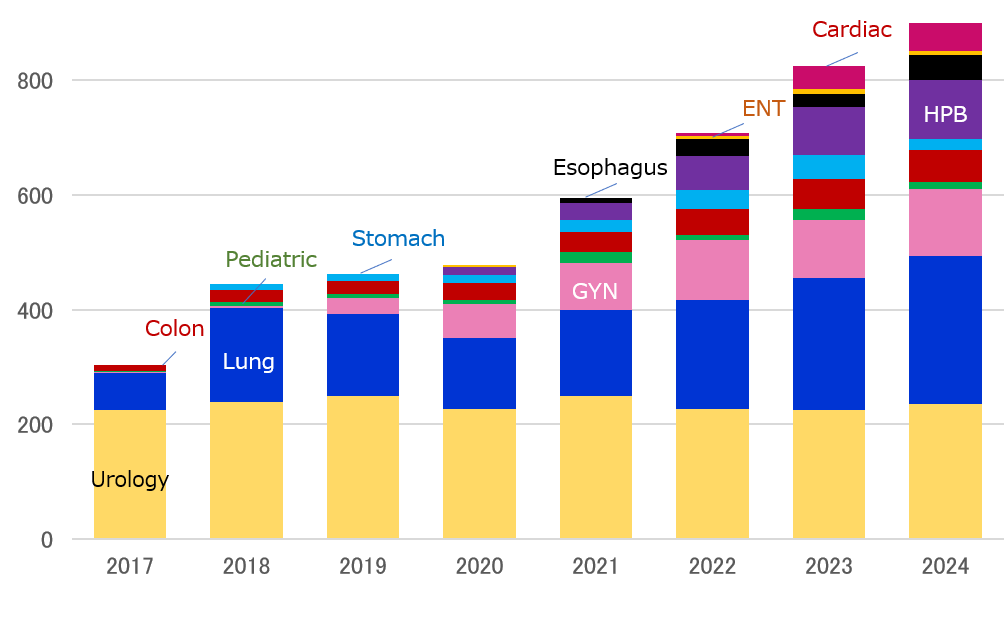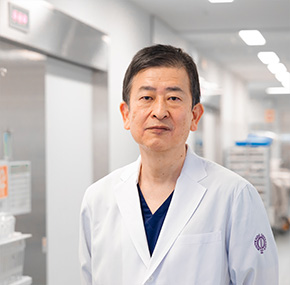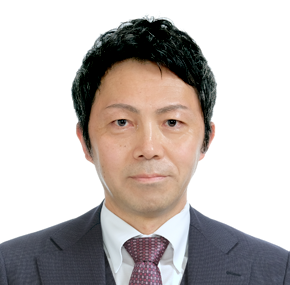- 順天堂大学医学部附属順天堂医院
- 順天堂医院について
- 順天堂の取り組み
- Robotic Surgery at Juntendo Hospital
Robotic Surgery at Juntendo Hospital
Minimally invasive surgery, which is performed through small incisions, reduces patient strain but has the drawback of making precise operations difficult.
The advent of robotic surgery has overcome this challenge.
Robotic surgery does not mean the robot performs the surgery on its own. Instead, thin robotic arms are inserted into the patient's body, and an experienced surgeon remotely controls these arms.
The robotic arms have many joints, allowing them to replicate the movements of the human hand accurately.
In 2024, we conducted 900 robotic surgeries.
Not only has the total number of surgeries increased, but the variety of procedures we can perform is also expanding yearly. To date, we have performed 5285 robotic surgeries.
Juntendo's robotic surgery is characterized by its foresight, diversity, and expertise.
The advent of robotic surgery has overcome this challenge.
Robotic surgery does not mean the robot performs the surgery on its own. Instead, thin robotic arms are inserted into the patient's body, and an experienced surgeon remotely controls these arms.
The robotic arms have many joints, allowing them to replicate the movements of the human hand accurately.
In 2024, we conducted 900 robotic surgeries.
Not only has the total number of surgeries increased, but the variety of procedures we can perform is also expanding yearly. To date, we have performed 5285 robotic surgeries.
Juntendo's robotic surgery is characterized by its foresight, diversity, and expertise.

Foresight
As robotic surgery is a new technology, it is essential to be well-versed in traditional surgical methods, including open and laparoscopic surgery.Based on our extensive surgical experience, we have been implementing robotic surgery since 2013. Our initiative spans multiple departments, where we've acknowledged the potential benefits of robotic surgery early on, adopting this innovative approach prior to its inclusion under national insurance coverage.
Diversity
To ensure safety and reliability, strict facility standards have been established for performing robotic surgery.Currently, patients can receive 28 types of robotic surgeries across 9 different departments.
For instance, simultaneous robotic surgeries on the colon and liver is possible due to the extensive expertise across departments. This breadth of experience allows us to offer surgical options that are uniquely available at our institution.
Expertise
To perform robotic surgery, physicians are required to obtain a specialized license and seek guidance under a supervisor (proctor).At our institution, we have 25 qualified proctor doctors.
The licensing process requires candidates to observe surgeries at designated specialized facilities. Notably, our thoracic surgery, gynecology, and hepato-pancreato-biliary surgery departments are acknowledged as premier specialized centers nationwide.
 Juntendo Hospital: Trends in the number of robotic surgeries
Juntendo Hospital: Trends in the number of robotic surgeriesRobotic Surgeries Available at Juntendo Hospital
Thoracic surgery

We were among the first to adopt robotic surgery for the treatment of lung cancer, even before it was included in insurance coverage. We have already performed over 1,000 surgeries for mediastinal tumors and lung tumors. Compared to traditional thoracoscopy, robotic surgeries enable us to safely perform complex operations that were previously not possible with minimally invasive techniques. However, there are cases where robotic surgery may not be the best option, and we ensure to accurately determine the most suitable approach for each patient.
We encourage those interested to consider a consultation with us. Free email consultations are available as well!
We encourage those interested to consider a consultation with us. Free email consultations are available as well!
Urology

Since 2013, our department has been utilizing the surgical assist robot, "da Vinci," to provide patients with minimally invasive care. We specialize in advanced robotic surgeries within the scope of insurance coverage for urological diseases, including prostate cancer, kidney cancer, bladder cancer, renal pelvis cancer, ureteral cancer, adrenal tumors, and ureteropelvic junction obstruction. We are particularly proud of our national leading case numbers in robotic prostatectomy for prostate cancer and robotic partial nephrectomy for kidney cancer. In treating bladder cancer, we can avoid open surgery and perform procedures such as ileal conduit formation and neobladder construction intracorporeally.
We continue to strive to provide appropriate medical care tailored to each patient's condition, aiming to deliver healthcare that prioritizes the health and peace of mind of our patients.
We continue to strive to provide appropriate medical care tailored to each patient's condition, aiming to deliver healthcare that prioritizes the health and peace of mind of our patients.
Gynecology

Our facility is renowned for having one of the highest numbers of laparoscopic surgery cases in Japan, and we have actively leveraged this vast experience to advance the implementation of robotic surgeries. By having experts in laparoscopic and oncological surgeries lead our robotic procedures, we provide high-quality operations that ensure safety and curative outcomes for both benign and malignant diseases.
Additionally, our hospital is certified as a site for observing robotic surgeries, enabling direct guidance from proctors (certified physicians).
Additionally, our hospital is certified as a site for observing robotic surgeries, enabling direct guidance from proctors (certified physicians).
Hepato-pancreatic-biliary surgery

In the treatment of complex diseases of the liver, bile ducts, and pancreas, surgery typically required large incisions. The introduction of robotic technology has fundamentally changed this paradigm.
Leveraging our extensive surgical experience with robotic assistance, we aim to “cure diseases with small incisions." Having met strict facility standards, we are now able to perform robotic surgeries for liver, bile duct, and pancreatic conditions under insurance coverage.
Leveraging our extensive surgical experience with robotic assistance, we aim to “cure diseases with small incisions." Having met strict facility standards, we are now able to perform robotic surgeries for liver, bile duct, and pancreatic conditions under insurance coverage.
Upper gastrointestinal surgery

Minimally invasive surgery for stomach and esophageal cancer offers advantages such as reduced pulmonary complications and less postoperative pain. Utilizing our experience in laparoscopic surgery since the 1990s, we also perform robotic surgeries for complex cases. The robot's ability to make precise, steady movements allows us to offer even less invasive treatments.
We are committed to providing minimally invasive surgeries that do not compromise radicality. Please feel free to consult us with any concerns.
We are committed to providing minimally invasive surgeries that do not compromise radicality. Please feel free to consult us with any concerns.
Colorectal surgery

We started robotic surgery for colorectal cancer in 2015. In 2018, we received accreditation for rectal cancer surgery, and by 2023, we had also gained facility certification for colon cancer surgery. To date, we have conducted robotic surgeries in over 200 cases of colorectal cancer.
Furthermore, we began robotic surgery for inguinal hernias in 2021 and have performed approximately 10 cases on a private basis so far.
Each of these surgeries has been safely implemented, and the minimally invasive nature of robotic surgery has proven to be beneficial for our patients.
Furthermore, we began robotic surgery for inguinal hernias in 2021 and have performed approximately 10 cases on a private basis so far.
Each of these surgeries has been safely implemented, and the minimally invasive nature of robotic surgery has proven to be beneficial for our patients.
Cardiovascular surgery

Since 2022, our department has introduced robotic surgery, performing operations for mitral valve insufficiency and tricuspid valve insufficiency.
Dr. Tabata is an expert with experience in over 1,500 endoscopic cardiac surgeries. Even without the use of robotics, Dr. Tabata can perform valvuloplasty and valve replacement through a small 3cm incision. There are patients who are suitable for robotic surgery and those who are not, and we select the most appropriate surgical method for each individual patient.
Our goal is to cure patients' valvular heart diseases, facilitating their swift reintegration into daily life while simultaneously ensuring their prolonged well-being.
Dr. Tabata is an expert with experience in over 1,500 endoscopic cardiac surgeries. Even without the use of robotics, Dr. Tabata can perform valvuloplasty and valve replacement through a small 3cm incision. There are patients who are suitable for robotic surgery and those who are not, and we select the most appropriate surgical method for each individual patient.
Our goal is to cure patients' valvular heart diseases, facilitating their swift reintegration into daily life while simultaneously ensuring their prolonged well-being.
Pediatric surgery

Our department was the first in Japan to introduce robot-assisted surgery (robotic surgery) for pediatric surgical diseases, and we currently have four physicians who are qualified to perform robotic surgery.
Using robot assistance allows for more precise operations than traditional laparoscopic and thoracoscopic surgeries, enabling us to safely perform procedures such as surgery for choledochal cysts, pyeloplasty, and mediastinal tumor resection. The number of robotic pediatric surgeries performed in our department is the highest in the country.
Using robot assistance allows for more precise operations than traditional laparoscopic and thoracoscopic surgeries, enabling us to safely perform procedures such as surgery for choledochal cysts, pyeloplasty, and mediastinal tumor resection. The number of robotic pediatric surgeries performed in our department is the highest in the country.
Otorhinolaryngology-Head and Neck Surgery

Since April 2022, robot-assisted transoral tumor resection for laryngopharyngeal cancer has been covered by regular health insurance. Our hospital was an early adopter, introducing robotic surgery in 2020.
The primary condition targeted by this surgery is oropharyngeal cancer. The use of the da Vinci robot's slender arms, inserted through the mouth and guided by 3D imaging, allows for precise surgical maneuvers, enabling accurate and safe removal of cancer. Compared to traditional methods that involve cutting open the neck, this approach significantly reduces damage to the patient.
The primary condition targeted by this surgery is oropharyngeal cancer. The use of the da Vinci robot's slender arms, inserted through the mouth and guided by 3D imaging, allows for precise surgical maneuvers, enabling accurate and safe removal of cancer. Compared to traditional methods that involve cutting open the neck, this approach significantly reduces damage to the patient.